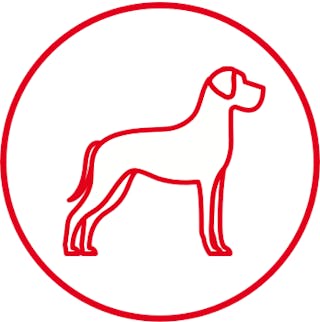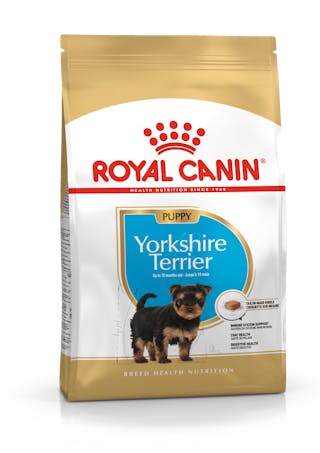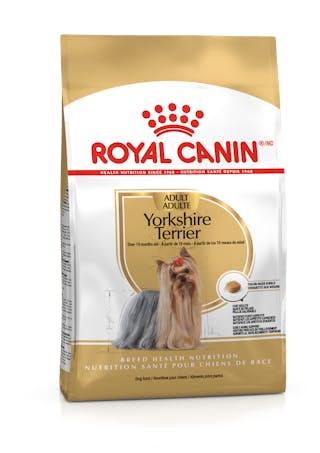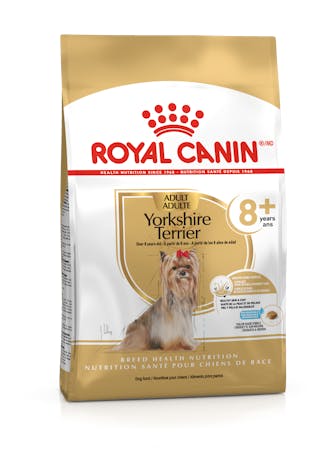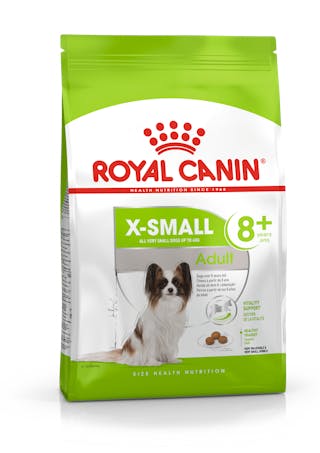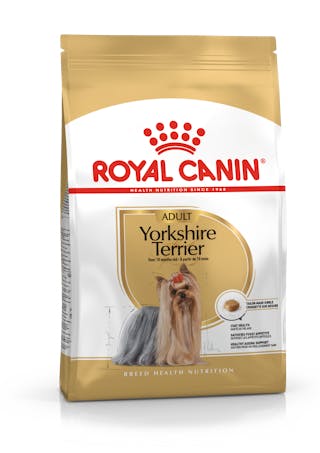
Let's talk Yorkshire Terriers
Petite but plucky, what they lack in size these diminutive dogs more than make up for in character. Known for their feisty yet friendly temperament, Yorkshire Terriers have bags of personality, make great company and form close attachments to their human families. With all the traits of a true terrier, they make good little watchdogs too. Given all this, and their glorious mane of long silky hair, they are often rightfully described as a ‘miniature lion’.
Official name: Yorkshire Terrier
Other names: Yorkie
Origins: United Kingdom

| Drooling tendencies |
|
Warm weather? |  |
| Grooming needs |  |
Cold weather? | |
| Shedding level |  |
Suited to apartment living? |  |
| Barking tendencies | Medium |
Can stay alone?* |  |
| Energy Level (high, low, medium)* | Low | Family pet?* |  |
| Compatibility with other pets |  |
* We advise against leaving pets alone for long stretches. Companionship can prevent emotional distress and destructive behaviour. Speak to your veterinarian for recommendations.
Every pet is different, even within a breed; this snapshot of this breed specifics should be taken as an indication.
For a happy healthy and well-behaved pet, we recommend educating and socializing your pet as well as covering their basic welfare needs (and their social and behavioral needs.
Pets should never be left unsupervised with a child.
Contact your breeder or veterinarian for further advice.
All domestic pets are sociable and prefer company. However, they can be taught to cope with solitude from an early age. Seek the advice of your veterinarian or trainer to help you do this.
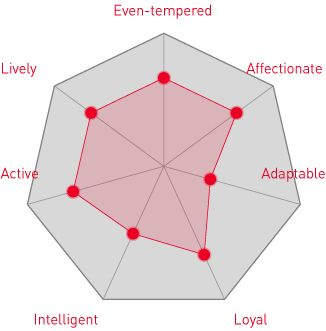

| Baby age | Birth to 2 months |
| Puppy age | 2 to 10 months |
| Adult age | 10 months to 8 years |
| Mature age | 8 to 12 years |
| Senior age | 12 to 22 years |

1/7
Get to know the Yorkshire Terriers
All you need to know about the breed
Don’t be deceived by that dainty demeanour, mane of silky hair and cute bow. They may look like they’re always in the salon, but the Yorkshire Terrier is a hardy, resilient and clever little dog. Every bit the terrier, they are bold, fearless and tenacious, the latter being a left-over from their former hunting days.
Bred in the north of England during the Industrial Revolution (yes, despite that haughty stance, their roots really are working class), the job of the Yorkshire Terrier was originally to keep the mines and textile mills free of vermin. It wasn’t until late Victorian times that they became popular as a lapdog – and began, quite literally, living in the lap of luxury among the English upper classes.
Certainly, with their regal-like bearing, it’s as if the Yorkshire Terrier was always destined for greater things. But, in reality, they are a friendly, playful breed with an inquisitive nature that makes them lots of fun.
Among other Yorkshire Terrier characteristics, they are fond of attention and like to stay close to their owners. They can be quite protective of them if the need arises and, in some cases, have the potential to be a bit yappy. For this reason, as well as their small size, they are better suited to families with older children.
Famed, of course, for their show-stopping silky coats, this is often topped off with a hair accessory to keep their locks out of eyes or there are various fashionable haircut styles. Interestingly, the Yorkshire Terrier’s long, slinky coat is exceptionally fine and more like human or horse hair. It does require a bit of care to keep it as its glossy best, but, on the plus side, the Yorkie is a breed that doesn’t really shed, so no vacuuming the sofa required.
As one of the smallest breeds of dog, the Yorkshire Terrier’s compact size means they’ll also fit in well to most home set-ups. Great companions for those living alone, the Yorkie is one of the longer-living breeds, too, and can easily reach their late teens. No wonder then that the Yorkshire Terrier is one of the most popular toy-dog breeds world-wide.

2/7
2 facts about Yorkshire Terriers
1. A tale of two terriers
In L. Frank Baum’s illustrated book, The Wonderful Wizard of Oz, the little dog Toto appears to have been a Yorkshire Terrier. However, when the story was made into a film, the starring role was stolen by a Cairn Terrier. The Yorkies got their revenge, though, with an appearance in the Audrey Hepburn movie, Funny Face, which featured her own dog.
2. Bending your ear...
In other fun facts about the Yorkshire Terrier, did you know that the puppies are born with floppy ears? What is more, in some cases, they remain that way for life. This is only an issue if you intend to show your Yorkie, as the judges look for upright ears in the breed, but it is in no way a problem for the dog. Also, many people find it a rather endearing quality.
History of the breed
Hailing from the north-east of England, Yorkshire Terriers are named after the county from which they originate. No surprises there. What is perhaps a little more unexpected is that their story is closely linked to the Industrial Revolution.
During that time, in the 1800’s, it was common for miners and mill workers to travel to the region seeking a job – and among them were a number of Scots. These would-be workers from the north brought with them their own breeds of terrier – and, in time, these Scottish dogs bred with the English varieties. This resulted in the Yorkshire Terrier breed that we know and love today.
Although we can’t be certain of their precise ancestry, it is thought the Yorkshire Terrier emerged from the crossing of at least three breeds of terrier – the old Black and Tab, the Maltese and the Skye. In any event, these tough little terriers went on to gain a reputation as an excellent hunting dog and were used to catch small vermin in the mines and mill buildings. The breed was officially recognised by the Kennel Club of England in 1886.
During the late Victorian era, the Yorkshire Terrier went on to become a popular companion animal – a lapdog favoured by the English upper classes. However, the breed’s popularity soon expanded far beyond Yorkshire and to the US. The Yorkie has been a firm favourite all over the world ever since.

4/7
From head to tail
Physical characteristics of Yorkshire Terrier
1. Head
Head and body covered with an abundance of silky hair.
2. Face
Face has quizzical brown eyes and a black nose, topped off with pricked ears.
3. Body
Body is small and compact with a straight back and well-proportioned components.
4. Fur
Colouring can vary in shades ranging from pale tan and russet gold to dark-steel blue, with white highlights.
5. Tail
Long, swishy tail shaped almost like that of a horse, carried slightly higher than the topline.

5/7
Things to look out for
From specific breed traits to a general health overview, here are some interesting facts about your Yorkshire Terrier
The little legs of the Yorkie need extra-special care
One of the most common complaints in the Yorkshire Terrier is a dislocated kneecap (luxating patella). Once known as ‘trick knee’ in humans, it occurs when the kneecap literally pops out of place. Symptoms can include obvious discomfort, limping or an odd ‘skipping’ walk – and it can also lead to arthritis in later life. As always, prevention is better than cure, so it’s best to keep your Yorkie away from anywhere they might try and jump. If, however, the condition does occur, there is plenty that can be done, ranging from muscle-building exercises and weight management to anti-inflammatory medications. Surgery has a good success rate.

6/7
Caring for your Yorkshire Terrier
Grooming, training and exercise tips
Despite their coiffured good looks, Yorkies are still terriers through and through. So they do require a reasonable amount of physical activity every day. With their history as working dogs, they also benefit from being occupied rather than too sedentary. Boredom can lead to your Yorkshire Terrier barking more than is necessary. A daily walk is the minimum and ideally two if possible. They also enjoy playing games with their owners – especially if it involves a ball – as well as plenty of interaction. But that should be a given.
Despite their long silky tresses, Yorkshire Terriers don’t tend to shed. However, their unique coat, closer to human hair, does require a gentle daily brushing to keep it looking its lustrous best. Extending almost to the ground if left to its own devices, it may also need an occasional trim. Regular baths are recommended – which is a chance to give their ears a check too – and nails should be clipped as needed. Other Yorkshire Terrier grooming tips include cutting their fringe to avoid it falling in their eyes. It can also be tied in that famous topknot with a bow. To keep things simple, some owners choose to have them clipped all over.
Though it’s true that they can be a bit stubborn at times, Yorkshire Terriers are generally eager to please. They are also fast learners and enjoy mental stimulation. This means they respond well to reward-based training. As this can also help cement the bond between dog and owner, it’s often an enjoyable process for both. Afterwards, Yorkshire Terriers can also excel at dog agility and obedience classes – and some go on to become excellent therapy dogs. Like other toy breeds, they can be a little slower to become house-trained, but they’ll get there with patience. In addition, early socialisation with people and animals will reap dividends later.
7/7
All about Yorkshire Terriers
If you’re wondering how long Yorkshire Terriers live for, the average age is around 12 to 15 years. However, they can potentially live into their late teens. On average, female Yorkshire Terriers live an extra one-and-a-half years compared to males.
If you’re wondering how long Yorkshire Terriers live for, the average age is around 12 to 15 years. However, they can potentially live into their late teens. On average, female Yorkshire Terriers live an extra one-and-a-half years compared to males.
Tailored nutrition for your Yorkshire Terrier
Read more on this topic

How your dog's nutrition needs change with age

How to adopt a dog

Things to consider before getting a dog
Sources
1 - Veterinary Centers of America https://vcahospitals.com/
2 - Royal Canin Dog Encyclopaedia. Ed 2010 and 2020
3 - Banfield Pet Hospital https://www.banfield.com/
4 - Royal Canin BHN Product Book
5 - American Kennel Club https://www.akc.org/

